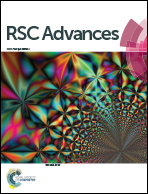Electrohydrodynamic printing of poly(3,4-ethylenedioxythiophene):poly(4-styrenesulfonate) electrodes with ratio-optimized surfactant†
Abstract
An electrohydrodynamic (EHD) printing process was optimized for the printing of a (3,4-ethylenedioxythiophene):poly(4-styrenesulfonate) (PEDOT:PSS) conductive polymer by manipulating the surface tension of a PEDOT:PSS solution. A stable cone-jet mode was confirmed by adjusting the process parameters of the EHD printing process, such as applied voltage, flow rate, and working distance. The addition of a nonionic surfactant, Triton X-100, enabled both printing of PEDOT:PSS conductive lines with widths ranging from 335 μm to 90 μm in a low-power operation (0.5 kV), as well as a 100-fold increase in conductivity of the PEDOT:PSS film compared with that of the pristine one. To utilize printed PEDOT:PSS lines for high functional applications, a multi-deposition technique was carried out, which results in a decrease in line resistance from 1.3 × 104 Ω mm−1 to 0.2 × 103 Ω mm−1.


 Please wait while we load your content...
Please wait while we load your content...